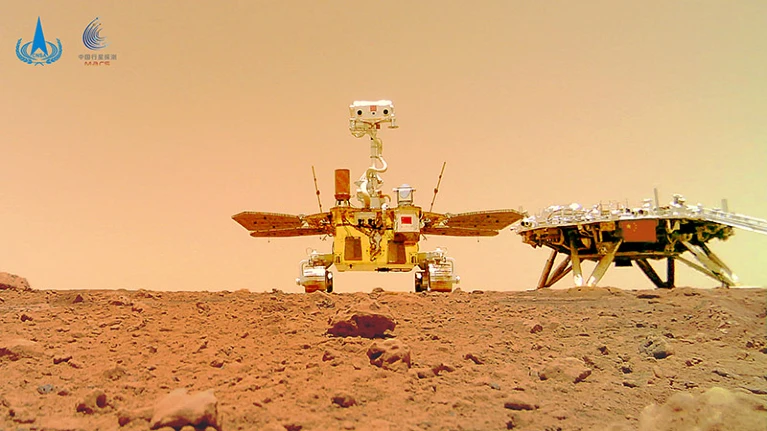
Is something amiss with Zhurong, China’s first Mars rover? The vehicle was supposed to come out of its months-long hibernation last month, but the Chinese space agency has been tight-lipped about its status, leading some researchers to speculate that it might not have survived the harsh Martian winter and dust storms.
“It wouldn’t be surprising for the rover to fail to come out of hibernation because it is solar-powered, and there’s a long history of solar-powered landers and rovers on Mars running out of power,” says David Flannery, an astrobiologist at Queensland University of Technology in Brisbane, Australia.
Flannery is part of the team working on NASA’s Perseverance Mars rover, which runs on nuclear power. Last month, researchers said goodbye to NASA’s solar-powered InSight lander, which succumbed to a dust storm.
But others remain optimistic that Zhurong will wake up in the next few months as temperatures warm up enough to charge its battery and as dust storms settle down. “I want to be optimistic that the rover will wake up,” says Baptiste Chide, a planetary scientist at Los Alamos National Laboratory in New Mexico, who is also part of the Perseverance team.
Zhurong jettisoned from the orbiter Tianwen-1 and plunged down to the vast Utopia Planitia impact basin in Mars’s northern hemisphere on May 15, 2021. It travelled nearly two kilometres from its landing site over the space of a year, exceeding its original mission goal of three months. The rover scoped out rocks, craters, sand dunes and even found evidence of past flooding from below the planet’s surface.
Last May, the China National Space Administration (CNSA) announced that it had powered Zhurong down because a major dust storm was heading its way. Dust swirling around the atmosphere reduces the amount of solar radiation that reaches the surface of Mars. And dust that settles on the rover’s solar panels can also reduce the amount of sunlight it receives, affecting its power generation, says Chide.
Zhurong’s solar panels are made of dust-repellent materials and can be angled to prevent dust settling. But combating dust is an ongoing problem for many Martian missions.
“That typically is what finishes a solar-powered mission in the end on Mars,” says Gregory Michael, a planetary scientist at the Free University of Berlin. Sometimes, whirlwinds known as dust devils, can come along and clear the dust off the panels, but that depends on luck, he says.
In May, the CNSA said that temperatures would drop to –20 °C during the day and –100 °C at night, and were expected to fall further. Cold temperatures mean that Zhurong needs more energy to keep its battery warm and prevent it from failing. To save energy, engineers typically shut off all scientific instruments, keeping only the communications system on for the rover to alert Earth when it wakes up. Chinese engineers have faced this problem before, says Chide – China’s solar-powered Yutu-2 rover has survived many long, cold nights on the lunar surface.
In September, a member of the Chinese team said they expected Zhurong to make contact when its energy levels had risen to 140 watts and the temperature of its components rose above –15 °C. They had initially expected that to happen by late December, at the end of the Martian winter and dust-storm season.
Researchers often develop models of the Martian atmosphere that can be used to predict when solar-powered spacecraft will revive, but they have lots of uncertainties, says Chide. “It is too soon to say that there is something wrong,” he says.
But the absence of an official update “is strange”, says a Chinese researcher and member of Zhurong’s science team, who requested anonymity to avoid repercussions from talking publicly before an official announcement. The last batch of images from Zhurong was received in June.
If the rover does eventually make contact, scientists will be ready. They hope that it will trundle to unusual geological formations nearby, including a barely visible ghost crater and a possible mud volcano. Together with laser instruments on Curiosity and Perseverance, Zhurong had been collecting data on the chemical make-up of Martian rocks. “I hope it will continue its traverse,” says Chide.
- A Nature report











